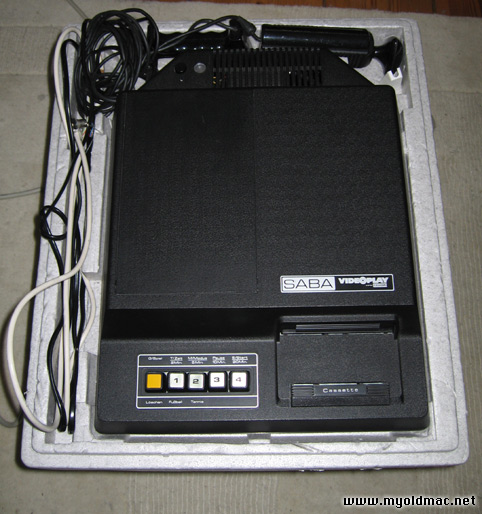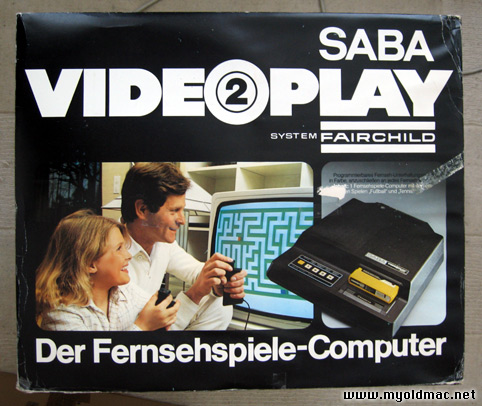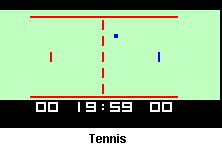| 
Lesen Sie die deutsche
Beschreibung
SABA Game System Fairchild - VIDEOPLAY 2 in original
box -

Here you find other
vintage computer collectors items.
The German version of the Fairchild Channel F in its
original package.. Looks a little different than it's
American, British, and Swedish counterparts. Has completely
ditched the Answering machine and tape recorder look
and goes for the late 70's stereo component thing instead.
The console itself is tested and works and the build
in games Tennis and Hockey start up, sharp screen -
tested on a B/W display.
Download the SABA
Fairchild Channel F Manual - FAQ here
The SABA Fairchild System is the world's first cartridge-based
video game console. It was released by Fairchild Semiconductor
(ostensibly by their parent company though) in August
1976 at a cost of $169.95. At this point it was known
as the Video Entertainment System, or VES, but when
Atari released their VCS the next year, Fairchild quickly
re-named it. A number of licensed versions were released
in Europe, including the Luxor Video Entertainment System
in Sweden, Adman Grandstand in the UK, and the Saba
Videoplay, Nordmende Teleplay and ITT Tele-Match Processor,
from Germany.
The console that changed home videogames as we know
them, the Fairchild Video Entertainment System (VES)
revolutionized an industry but soon suffered for it.
By 1976, the Pong-driven videogame industry was starting
to decline in popularity due to oversaturization, caused
by "me too" companies flooding the market
with cheap imitations. At this point, Fairchild entered
the market with a new machine that wasn't a "me
too" device at all.
The Fairchild VES was designed at Fairchild Camera
and Instrument Corporation, most known for their subsidiary
Fairchild Semiconductor, whose chips the console was
based around. Though little is currently known about
the origins of the console, someone at Fairchild must
have decided that the company should enter the new videogames
market with a bang. Using one of their own microprocessors
(still a very new concept in 1975), design of the console
was centered around its being programmable.
This was wildly different than the normal, still-evolving
Pong systems, which were dedicated to only playing simple
games with a multitude of variations at the flick of
a switch. Fairchild's new console featured plug-in cartridges
that contained ROM chips with actual microprocessor
code, rather than dedicated circuits like those used
in the plug-in cards of the original Odyssey game system.
So instead of the short shelf-life common to Pong systems,
Fairchild's console could now be continuously renewed
by simply plugging in game cartridges, which they called
"Videocarts." With the possiblity of new Videocarts
released at any time, the potentially long lifetime
of the console seemed very attractive to Fairchild.
Big whoop you say? "You're just describing videogame
cartridges." Aha, but remember ? this was 1976.
This was THE first cartridge system, and it established
a format that was to be used by almost every game company
for years to come. Even today, when cartridges are finally
being phased out in favor of CD-based consoles, they
are still the de facto standard for handheld gaming
systems, such as Nintendo's Game Boy series.
External links:
SABA Game System Fairchild - VIDEOPLAY 2 -

Hier finden Sie meine anderen
Computer Sammlerstücke.
Ein SABA Fairchild Video Play 2 System in der original
Verpackung. Die Konsole ist getestet, das interne Spiele
Hockey und Tennis starten und der Screen ist scharf.
Die Videoplay-Konsole von Saba ist ein Clone des Fairchild
Channel F, des ersten Telespiels mit austauschbaren
Modulen.
So revolutionär die Idee mit den austauschbaren
Spielen bei Erscheinen der Konsole auch war (vorher
gab es nur Konsolen mit eingebauter Software, meistens
Pong), die Technik des Videoplay konnte mit dem kurze
Zeit später auf den Markt gebrachten Atari VCS
nicht mithalten.
Die Spiele für Channel F/Videoplay sind grafisch
nicht sehr aufwendig (vergleichbar mit sehr frühen
VCS-Titeln, eher darunter) und vom Spielprinzip her
meist simpel. Es macht aber teilweise trotzdem sehr
viel Spaß damit zu spielen, besonders wegen der
bemerkenswerten Steuerknüppel (die übrigens
fest mit der Konsole verbunden sind).
Diese Knüppel sind nämlich nicht nur Joysticks,
die sich in die bekannten vier bzw. acht Richtungen
bewegen lassen, man kann den Knauf auch als Paddle benutzen
und ihn links- und rechtsherum drehen (das muß
vom entsprechenden Spiel natürlich unterstützt
werden). Knifflig wird die Sache spätestens dann,
wenn man auch noch feuern muß, denn auch dazu
dient der Knauf - man kann ihn runterdrücken und
sogar hochziehen (separate Feuerknöpfe gibt es
nicht). Diese Aktionen alle gleichzeitig auszuführen
kann schon zu einer gewissen Hektik beim Spielen führen...
;-)
Es gibt von Saba zwei verschiedene Modelle, Videoplay
und Videoplay 2. Beide unterscheiden sich allerdings
nur marginal voneinander, die auffälligste Änderung
sind die Steuerknüppel. Ansonsten sehen beide Konsolen
gleich aus; es wurden auch schon Geräte gefunden,
die außen als Videoplay und innen als Videoplay
2 beschriftet sind.
Downloaden Sie das englische SABA
Fairchild Channel F Manual - FAQ hier.
Externe Link:
Photos

The SABA Fairchild VideoPlay System - in its original
package
Das SABA Fairchild VideoPlay System in der original
Verpackung

The original German package
Die original Verpackung

The build in game Tennis
Das Eingebaute Spiel Tennis |